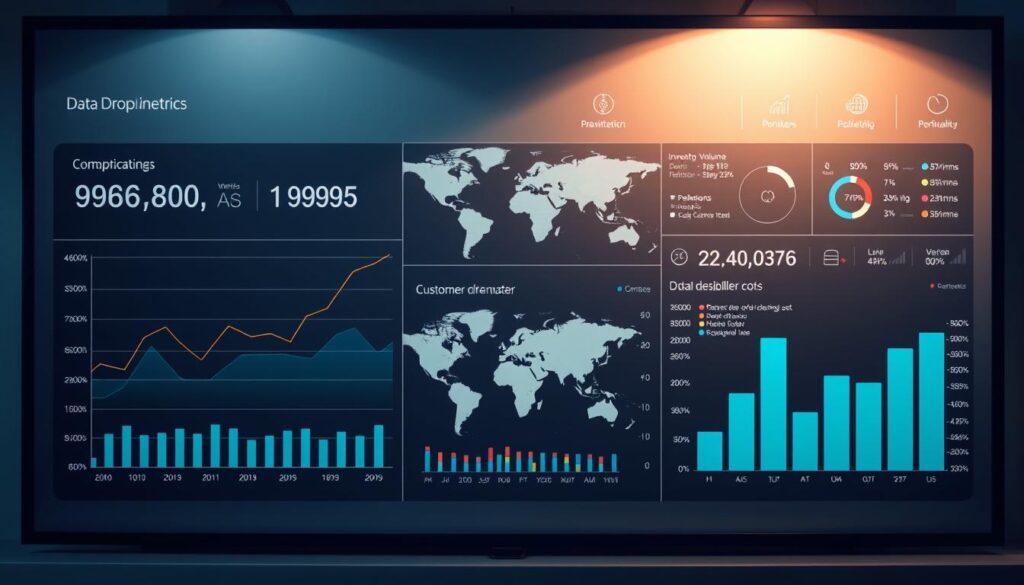Ever thought about starting a business without handling the products yourself? The dropshipping model is a great way to do just that. It’s perfect for those new to e-commerce, as it involves little risk. In this guide, we’ll cover everything you need to know to start dropshipping.
We’ll talk about the basics of the model, finding the right niche, and setting up supplier partnerships. Plus, we’ll share tips on marketing your store. Get ready to learn how to start your dropshipping journey!
Understanding Dropshipping: What You Need to Know
Dropshipping is a way for entrepreneurs to sell products without keeping them in stock. It’s a simple way to start a business without dealing with inventory. Knowing how dropshipping works is key for those new to business.
Definition of Dropshipping
So, what is dropshipping? It’s a model where you sell products without storing them. You take orders and send them to a supplier. They then ship the products to your customers. This way, you don’t have to worry about inventory.
How It Works
The dropshipping model is easy to understand. When a customer orders, you send the details to the supplier. They pack and ship the product. This lets you focus on marketing and helping customers, not on logistics.
Benefits of Dropshipping
Dropshipping has many benefits. For one, it’s cheap to start, as you don’t need to buy inventory. You can set up an online store easily with platforms like Shopify. It also lets you try new products without big risks.
But, there are downsides. You might make less profit, and managing suppliers well is important. These challenges need to be considered.
Choosing the Right Niche for Your Business
Finding the right niche is key for a successful dropshipping business. You need to do deep research to match your products with what people want and what you love. Looking at trending products helps you find what customers are buying. Knowing your competition helps you see where you stand in the market.
Researching Trends
Today’s market moves fast, so knowing what’s trending is important. Google Trends shows what people are into right now. By watching these trends, you can spot chances for your business to grow. Focusing on popular items makes your business more visible in a busy market.
Evaluating Competition
It’s important to study your competition to understand your niche. Look at what others are doing, like their prices and how they talk to customers. This helps you come up with marketing ideas that make your business stand out.
Finding Your Passion
Being passionate about your niche makes marketing easier and more genuine. When you love what you sell, it’s easier to connect with your customers. This builds loyalty and makes your brand stronger. Specializing in a niche can make your store unique, keeping customers coming back.
Selecting Reliable Suppliers
Starting a dropshipping business needs reliable suppliers. These partnerships are key for quality products, on-time delivery, and good customer service. It’s important to know how to find the right suppliers in a competitive market.
Importance of Supplier Relationships
Good supplier relationships make your dropshipping business run smoothly. Reliable suppliers offer quality products and help your business’s reputation. They ensure fast transactions, timely shipping, and help solve problems together.
Platforms to Find Suppliers
Many dropshipping platforms can help you find suppliers that fit your business. Some popular ones are:
- SaleHoo: A known directory for finding verified suppliers.
- Oberlo: Works well with Shopify, providing many product options.
- Syncio Marketplace: Helps connect suppliers and sync products for online stores.
Qualities to Look for in Suppliers
When choosing suppliers, look for these key qualities for a successful partnership:
| Quality | Description |
|---|---|
| Competitive Pricing | Suppliers should have prices that let you make a profit while staying competitive. |
| Reliable Inventory Management | Suppliers need to manage their stock well to avoid stockouts or delays. |
| Responsiveness | A good supplier should quickly answer questions and solve problems, improving the experience. |
Setting Up Your Online Store
Creating a successful online store needs careful thought. You must first pick a dropshipping platform. You might choose between Shopify and WooCommerce, each with its own benefits. The design of your store is key to keeping customers engaged and boosting sales.
Adding important features can also make your store better for users.
Shopify vs. WooCommerce
Deciding between Shopify and WooCommerce means knowing what each offers:
| Feature | Shopify | WooCommerce |
|---|---|---|
| User-Friendliness | High | Medium |
| Customization Options | Limited | Extensive |
| Payment Gateway Options | Integrated | Varies |
| Support | 24/7 | Community-Based |
Designing Your Storefront
Good design is essential for attracting customers. Make your storefront look great and be easy to use. Think about colors, fonts, and layout. Also, listen to what users say to make sure your design meets their needs.
Essential Features for Success
A successful online store has key features:
- Secure Payment Gateway: Keeping customer info safe builds trust.
- Mobile Responsiveness: Make sure your site works well on all devices to reach more people.
- Customer Support Tools: Adding live chat or email support can enhance the shopping experience.
Creating a Business Plan
Making a detailed dropshipping business plan is key for your startup journey. It acts as a roadmap, showing your strategies, goals, and how to run your business. Knowing the value of planning helps you make smart decisions.
Importance of Planning
Planning is very important for a dropshipping business. A good plan outlines your business model and who you’re targeting. It also covers your marketing plans. Planning helps you get ready for different market situations.
Key Components of a Dropshipping Plan
Here are the main parts of a dropshipping plan:
- Market Analysis: Know what customers want and spot trends in your industry.
- Budget Forecasts: Make financial predictions to use your resources wisely.
- Marketing Strategy: Plan how to reach customers through social media, SEO, and email marketing.
Use tools like platforms to find reliable suppliers to improve your plan. This ensures you have the right partners for your business.
Setting Goals
Setting clear dropshipping goals is essential. Goals help you see how you’re doing and improve your plans. Whether it’s about sales or customer happiness, having goals helps you stay focused and improve where needed.
Legal Considerations for Dropshipping
Starting a dropshipping business means you need to know the law. Understanding dropshipping legalities is key to keeping your business running smoothly. Each place has its own rules for business licenses and taxes.
Business Licenses
Make sure you get the right business licenses before you start. The license you need depends on your business type, like if it’s just you or an LLC. Check your local laws to avoid trouble later.
Tax Requirements
Knowing your taxes is important for a dropshipping business. Sales taxes vary by state, so you need to know where your customers are. This helps you avoid legal issues. Keeping good records makes tax time easier.
Terms and Conditions
Having clear terms and conditions is essential. They explain how you handle orders, returns, and shipping. Good terms protect both you and your customers. They also help clarify who’s responsible in different situations.

| Legal Aspect | Description |
|---|---|
| Business Licenses | Required permits that vary based on business structure and location. |
| Tax Requirements | Obligations related to sales tax, which differ by state. |
| Terms and Conditions | Documentation outlining customer agreements and business policies. |
Marketing Your Dropshipping Store
Effective marketing is key to getting more people to see your dropshipping store. Using social media, SEO, and email marketing together can really help. This mix can make your store more successful.
Utilizing Social Media
Social media sites like Instagram, Facebook, and TikTok are great for reaching lots of people. Videos can convince 84% of consumers to buy. Working with influencers can also bring in big results, with an average return of $5.78 for every dollar spent.
Using tools like Buffer helps manage posts on different platforms at once. This makes it easier to keep your social media active.
SEO Strategies
Good SEO is vital in the competitive dropshipping world. It brings in organic traffic and makes your store more visible. Focus on the right keywords, write engaging product descriptions, and use high-quality images.
Keep your content fresh, use blogs, and stay on top of trends. This will help your store rank higher in search results.
Email Marketing Tips
Email marketing is a powerful tool for getting more sales and keeping customers interested. You can build an email list in many ways, like with pop-up offers or at checkout. Send out regular updates on promotions, new products, and helpful tips.
This builds strong customer relationships and encourages them to come back. Using these strategies together can really boost your marketing efforts.
| Marketing Strategy | Benefits | Key Tools |
|---|---|---|
| Social Media | Widespread reach and customer engagement | Buffer, Hootsuite |
| SEO | Increased organic traffic and visibility | Google Analytics, SEMrush |
| Email Marketing | Direct communication with customers | Mailchimp, Constant Contact |
For more tips on dropshipping marketing, check out this in-depth guide. By combining social media, SEO, and email marketing, you can create a powerful marketing system.
Managing Customer Service
Customer service is key to a dropshipping business’s success. A good experience can lead to more repeat customers and word-of-mouth. Keeping customers happy through clear communication and support makes them feel important.
Importance of Customer Experience
Understanding and quickly meeting customer needs is vital. Using social media, emails, and live chats helps build trust. Quick and friendly service sets a business apart from the competition.
Handling Returns and Refunds
Having clear return and refund policies is important for customer happiness. A fair policy reduces worries about buying. Quick handling of returns makes customers more likely to shop again, knowing they can return items if needed.
Building Customer Loyalty
Keeping customers for the long term means personal touches and rewards. Loyalty programs and listening to feedback boost engagement. Customers stick with brands that listen and support them well.
| Customer Experience Strategies | Impact on Customer Loyalty |
|---|---|
| Personalized Communication | Increased trust and rapport |
| Clear Return Policies | Enhanced confidence in purchases |
| Loyalty Rewards Programs | Encouragement of repeat purchases |
| Active Feedback Engagement | Improved satisfaction and retention |
Analyzing Your Business Performance
It’s key to regularly check how your dropshipping business is doing. Knowing your KPIs, like sales, conversion rates, and how much it costs to get a customer, helps you see how well you’re doing. By keeping an eye on these numbers, you can learn more about your customers and make changes to grow your profits.
Key Performance Indicators (KPIs)
Choosing the right KPIs is vital for any dropshipping business. Here are some important ones to watch:
- Cost of Goods Sold (COGS): This helps figure out your profit margins.
- Customer Acquisition Cost (CAC): Shows how much it costs to get each new customer.
- Average Order Value (AOV): A higher AOV means more profit.
- Conversion Rate: Tells you how many visitors actually buy, showing where you can improve.
- Cart Abandonment Rate: A high rate means problems with the checkout process.
Using Analytics Tools
Using analytics tools makes it easier to check your dropshipping business’s performance. Tools like Google Analytics give you deep insights into customer behavior. This helps you see what’s working and what’s not, and adjust your strategies to meet market needs.
Making Data-Driven Decisions
Using data to make decisions improves how your business runs. By regularly checking your KPIs and using analytics tools, you can fine-tune your approach. This leads to better marketing, a smoother sales process, and higher profits. For more on tracking KPIs, check out essential KPIs for dropshipping businesses.

Scaling Your Dropshipping Business
To grow your dropshipping business, you need a solid plan. This includes adding new products, exploring new markets, and using automation. These steps help you meet demand while keeping your service top-notch.
Expanding Product Lines
Adding new products is key to growing your business. It lets you reach more customers and meet their needs. This can bring in new buyers and get existing ones to buy more.
Choosing products wisely is important. Look at what’s trending and what customers want. Tools that analyze market data can help you pick the right products. This way, you can build a strong inventory that meets demand.
Exploring New Markets
Entering new markets can really boost your growth. You can reach more customers, both at home and abroad. It’s important to understand the local culture and what people like.
By finding markets that are not well-served, you can grow your sales. This approach helps your business grow in a sustainable way.
Automating Processes
Automation is a game-changer for your business. It makes tasks like managing inventory and handling orders easier. This lets your team focus on important tasks.
Automation can cut down on mistakes by up to 90%. It also helps you handle more orders without sacrificing quality. This makes customers happier and more likely to stay with you.
| Automation Benefits | Manual Processes |
|---|---|
| Reduces operational errors by 90% | Higher error rates impacting customer satisfaction |
| Increases order processing speed by 3X | Slower processing leading to shipping delays |
| Enhances customer engagement by 60% | Limited interaction with manual systems |
| Boosts average order values by 28% | Fewer upselling opportunities |
Common Mistakes to Avoid
Knowing dropshipping mistakes can greatly improve your business. Spotting common pitfalls helps streamline operations and build stronger customer ties. By focusing on simplicity, listening to customers, and investing in marketing, you can grow and sustain your business.
Overcomplicating Your Business
Many dropshippers make the mistake of overcomplicating things. Adding too many steps can confuse and slow growth. Keeping things simple makes management easier and allows for quick changes when needed. Focus on what’s essential and cut out the rest.
Ignoring Customer Feedback
Customer feedback is a goldmine for improvement. Not listening to it can hurt product quality and satisfaction. By paying attention to what customers say, you can improve your products and build loyalty.
Underestimating Marketing Efforts
Businesses that don’t invest in marketing often struggle to grow. Good marketing brings in new customers. A solid plan can boost sales and reach more people. Always look to improve your marketing to stay ahead.
| Mistake | Description | Impact | Solution |
|---|---|---|---|
| Overcomplicating Processes | Adding unnecessary steps that make operations difficult. | Slower growth and increased confusion. | Simplify operations to focus on core activities. |
| Ignoring Feedback | Not considering customer insights for improvement. | Reduced satisfaction and missed opportunities. | Regularly collect and analyze customer feedback. |
| Underestimating Marketing | Failing to recognize the importance of a solid marketing plan. | Limited outreach and sales stagnation. | Invest in diverse marketing strategies for maximum effect. |
Staying Informed about Industry Trends
In the fast-paced world of dropshipping, it’s key to stay updated on trends. Reading influential e-commerce blogs helps you understand new strategies and market changes. These blogs share tips from successful dropshippers and offer insights to improve your business. For example, detailed trend analyses are great for staying ahead.
Joining dropshipping communities on Facebook and Reddit is also helpful. These forums are where people share advice and solutions. It’s a great way to connect with others and get support for your e-commerce journey.
Also, don’t miss out on ecommerce webinars and industry conferences. These events feature experts who talk about the latest trends. By keeping up with these, you can adapt your business to the changing market.
FAQ
What is dropshipping?
Dropshipping is a way to sell products online without keeping any stock. You send orders to suppliers who then ship them directly to customers.
How do I start a dropshipping business?
Starting a dropshipping business involves a few steps. First, pick a niche you’re interested in. Then, find reliable suppliers. Next, set up an online store and plan how to market it.
Understanding how dropshipping works and building good relationships with suppliers are key.
What are the best dropshipping products to sell?
The best products to sell depend on current trends and what you like. Use tools like Google Trends to find popular items. Also, look at what others are selling to pick the right products for your niche.
What are some effective dropshipping strategies?
Good strategies include focusing on a specific niche and building strong supplier relationships. Use social media and SEO to get more visibility.
What are common pitfalls in dropshipping?
Mistakes to avoid include making things too complicated and ignoring what customers say. Don’t underestimate the power of good marketing. Knowing these pitfalls and keeping things simple can help.
How can I analyze my dropshipping business performance?
To check how your business is doing, track important numbers like sales and how many people are converting. Tools like Google Analytics can give you insights into how customers behave and how your site is doing.
What legal considerations should I be aware of in dropshipping?
Important legal things to know include getting the right business licenses and understanding taxes like sales tax. Make sure you have clear terms and conditions to protect your business.
How can I effectively market my dropshipping store?
Good marketing includes using social media, SEO to get more organic traffic, and email marketing to keep customers interested.
What are the best dropshipping platforms?
Popular platforms include Shopify for its ease of use and WooCommerce for customization options. Picking the right platform is important for a successful online store.
How can I build customer loyalty in my dropshipping business?
To keep customers coming back, offer great service, have clear return policies, personalize communication, and create loyalty programs.
I’m into tech, trends, and all things digital. At CrazeNest, I share what’s new, what’s next, and why it matters — always with a curious mind and a creative twist.





